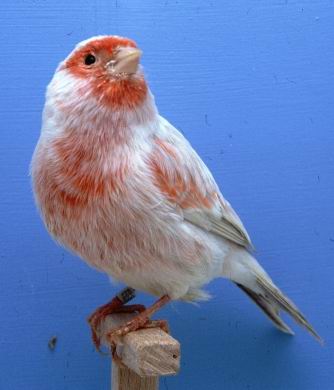Canary - Colored
Red Canary, Red Factor Canary, Red Factor Crested Canary, Red Lipochrome Colour Canary, Clear Red Canary, Colourbred Canary Scientific Name: Serinus canaria
Thu, 10th July, 2025 - 12:32 am GMT
Sponsor Ads:

Alternative Name
Red Canary, Red Factor Canary, Red Factor Crested Canary, Red Lipochrome Colour Canary, Clear Red Canary, Colourbred Canary Scientific Name: Serinus canariaBasic Info
There are a couple of hundred various colors which comprise the group known as Colourbred Canaries. Only some of these colors include red, or, what is known as red-ground. The hallmark of the Colourbred Canary is his brilliantly colored plumage. In order to enhance the color of the Red canaries in this group, most enthusiasts will recommend "color feeding". Color feeding is the feeding of foods specifically designed to enhance color, and this method is used with yellow and rose ground colors, as well as reds. Many canary breeds will exhibit an increase in red or orange color by simply feeding things like cayenne pepper and paprika. Experts recommend using a carotenoid concentrate to bring out the potential in your red canary's plumage.
Health
There is a risk to the bird's liver and kidneys if too much of the carotenoid concentrates used for this purpose are fed, so it is always advised to consult your veterinarian regarding the best possible choices in your canary's diet. It should be noted that most experts seem to hold that there are not health risks associated with carotenoid concentrates, as long as the doses are administered in the correct quantities and are not fed continuously all year round. Color-feeding is needed slightly before and during the annual summer molt and should not be done throughout the rest of the year. Breeding Breeding of Canaries is not easy and should not be tried before doing extensive research. Unlike many other breeds of bird, canaries rely on photosensitivity for breeding. They are brought into their breeding season by the length of daylight in the springtime.Habitat
N/ABehavior
The Colourbred Canary displays a remarkable elegance and beauty. Named after its beautiful plumage it is no surprise that this Canary is kept by many worldwide. The Colourbred Canary, which includes many exotic colored canaries such as the red, white, rose, bronze, brown, and mosaic canaries, is an active, entertaining bird that has delighted people for years. Like all canaries, Colourbred Canaries do not, as a rule, like to be handled. If you are looking for a bird that likes to be held and snuggled, canaries are not the birds for you. Most canaries are territorial, and therefore should not be expected to willingly share a cage. They are not a social species and rarely if ever need company. Of course every individual is different, but do not assume your canary will do well in a cage with other birds. Most likely, it will do much better if caged separately.Origin
Wild canaries of the Canary IslandsHistory
Like other canaries, Colourbred Canaries can trace their origins to the wild canaries of the Canary Islands, which were first introduced to Europe by the Spanish. The name "Red Factor" is commonly (and erroneously) used for red colored birds in this group and stems from the history of this color's development in the canary, which came through the introduction of a genetic factor for red colored feathers into the gene pool of the Common Canary. The original red canaries were produced from the rare fertile hybrid offspring of a Venezuelan Red Siskin (South American Black-Capped Red Siskin) crossed with a normal yellow-ground canary. The red canary and all the other Colourbred Canary colors were developed entirely in captivity and do not occur in the wild.Common Foods
N/ASponsor Ads:
Locks and keys are for honest people. -- Unknown
Canary - Colored
Coded by: BGID® | ALL RIGHTS RESERVED Copyright © 2000-2025
Disclaimer | Privacy | Report Errors / Contact | Credits
















